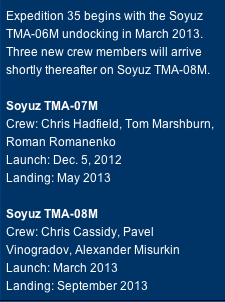-

-

-

Russian cosmonaut Pavel Vinogradov (center), Expedition 35 flight engineer and Expedition 36 commander; along with NASA astronaut Chris Cassidy (right) and Russian cosmonaut Alexander Misurkin, both Expedition 35/36 flight engineers, participate in an emergency scenario training session in the Space Vehicle Mock-up Facility at NASA's Johnson Space Center. Photo credit: NASA
-

Canadian Space Agency astronaut Chris Hadfield (left), Expedition 34 flight engineer and Expedition 35 commander; NASA astronaut Chris Cassidy (center), Expedition 35/36 flight engineer; Russian cosmonaut Pavel Vinogradov, Expedition 35 flight engineer and Expedition 36 commander; and Russian cosmonaut Alexander Misurkin (left background), Expedition 35/36 flight engineer, participate in an emergency scenario training session in an International Space Station mock-up/trainer in the Space Vehicle Mock-up Facility at NASA's Johnson Space Center. Photo credit: NASA
-

NASA astronaut Chris Cassidy, Expedition 35/36 flight engineer, gets help donning a training version of his Extravehicular Mobility Unit (EMU) spacesuit in preparation for a fit check in the Space Station Airlock Test Article (SSATA) in the Crew Systems Laboratory at NASA's Johnson Space Center. Photo credit: NASA
-

NASA astronaut Chris Cassidy, Expedition 35/36 flight engineer, participates in an Extravehicular Mobility Unit (EMU) spacesuit fit check in the Space Station Airlock Test Article (SSATA) in the Crew Systems Laboratory at NASA's Johnson Space Center. Photo credit: NASA
-

NASA astronaut Chris Cassidy, Expedition 35/36 flight engineer, participates in an Extravehicular Mobility Unit (EMU) spacesuit fit check in the Space Station Airlock Test Article (SSATA) in the Crew Systems Laboratory at NASA's Johnson Space Center. Technicians assisted Cassidy. Photo credit: NASA
-

NASA astronaut Chris Cassidy, Expedition 35/36 flight engineer, prepares for a flight in a NASA T-38 trainer jet at Ellington Field near NASA's Johnson Space Center. Photo credit: NASA
-

Quelle: NASA
-
Update: 11.12.2012

(From left) Flight Engineers Chris Hadfield, Roman Romanenko and Tom Marshburn are seen in front of the Soyuz TMA-07M spacecraft they launch in Dec. 19. Credit: NASA
Medical Ops, Fan Checks for Space Crew; New Trio Checks Soyuz
